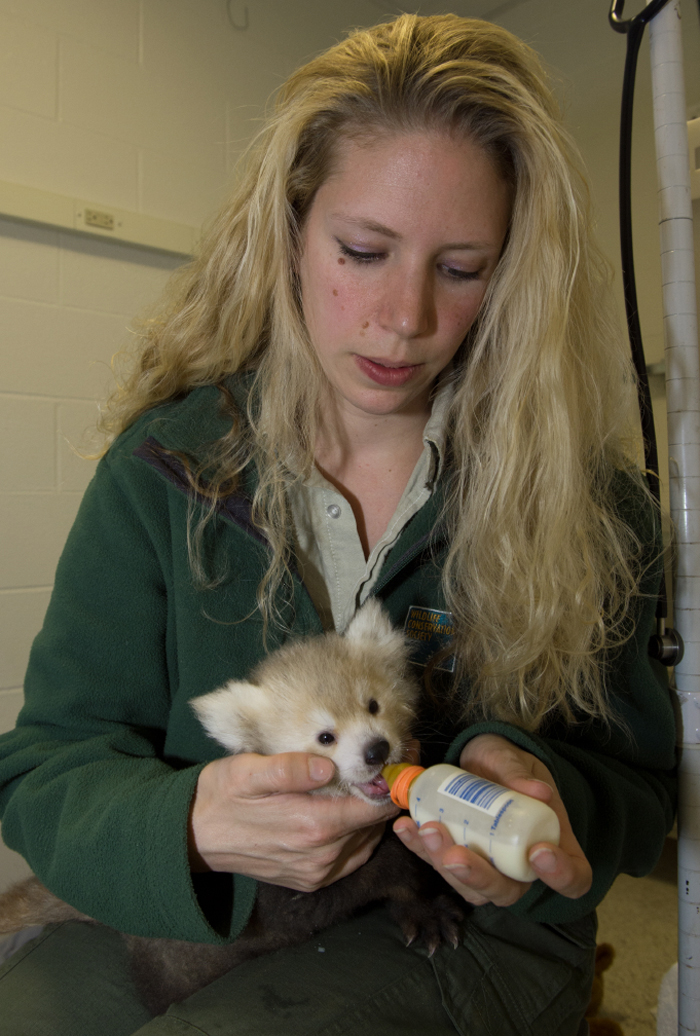Only Zookeepers Get to Feed the Penguins (Op-Ed)


Nora Beirne, a senior keeper at the Wildlife Conservation Society (WCS), contributed this article to Live Science's Expert Voices: Op-Ed & Insights.
People who love animals sometimes think their only career path is to study medicine and become a veterinarian. Children are not usually told they can be a zookeeper when they grow up.
My parents wanted me to be a doctor. When I went to The College of New Jersey, I was an English major, but I took several pre-med classes. Then, in my senior year, Pat Thomas — associate director of the Bronx Zoo and vice president and general curator for the Wildlife Conservation Society — gave a talk to the biology department. He mentioned the research that happens at zoos, and how a person can take what's learned from animals there and bring that knowledge to the field. It suddenly clicked: I could be a researcher, a keeper.
In six years as a zookeeper, I've trained red pandas for injections, fed black bears jelly off a spoon and held a komodo dragon.
I began my career at the Turtle Back Zoo in West Orange, N.J., before coming to the WCS's Central Park Zoo in 2010. The work can be intensive — early in my time at the Central Park Zoo, I helped raise eight penguin chicks. I'd measure out a formula list of vitamins, fish and water — every day the percentages changed. There's a manual on how to raise these chicks and how much to feed them based on body weight and age. My colleagues and I regulated the temperature of their enclosure, and we fed and cleaned up after them constantly. The efforts did not go unrecognized — some of the penguins still recognize me when I visit.
Our animals also get enrichment to encourage natural behaviors. We'll leave a scent like oregano, catnip or different perfumes for some of the large cats, for example, to promote exploration and scent marking. For aquatic animals like sea lions we offer frozen fish treats or large ice blocks scented with vanilla (which stimulates play behavior and keeps the animals from swimming in circles all day).
Sometimes visitors will see us feeding the sea lions and say, "That's the best job in the world — you get to play with animals all day." I wish that were the case — part of our job is to clean exhibits and perform duties that require intense physical work like weeding and shoveling. We also have to work through holidays, heat waves, and snow storms to feed and care for the animals.
Get the world’s most fascinating discoveries delivered straight to your inbox.
And there can be some unusual occupational hazards. When penguins are hungry, they will make it known. They like to bite hard! They get you right on the shins and the back of the knee.
As a keeper, one of my favorite responsibilities is to work with large cats, and one of my favorite stories involves Leo — the snow leopard who became famous when he was rescued as a young cub in the high mountains of northern Pakistan. His journey to New York shows the critical role zoos play in conservation. Orphaned in the remote Naltar Valley, Leo could not be returned to the wild because he had not had a chance to learn necessary survival skils from his mother. Because there were no suitable facilities for snow leopards in Pakistan, Leo was brought to the Bronx Zoo in 2006. Last year he sired his first cub.
We work closely with all our animals, not just Leo. For example, we trained our female snow leopard Zoey using positive reinforcement — in which rewards are provided as incentives to encourage an animal to express desired behaviors. She went from learning how to sit and lie down to voluntarily accepting ultrasound exams and blood tests. Teaching her commands was challenging but fun. The goal was to desensitize her to an ultrasound wand and get her comfortable with the smell of rubbing alcohol, which has to be used to wet down the belly for the medical procedure. You never know what behaviors will be hardest to teach. While it took only a few weeks to train her for ultrasounds, I've been working with her for months to get her to open her mouth on command.
There are many rewards for being a zookeeper. I get to visit other zoos and attend conferences and workshops to continue training and growing in my profession, and I love sharing my enthusiasm with the public, so people can appreciate animals like I do. I explain that our animals are ambassadors for those in the wild.
And if our animals are the ambassadors, I like to consider myself their translator. I lend them my voice to share their stories and excite people about wildlife and conservation. While I might not have the usual credentials for a conservation career and it’s not the easiest profession, there is nothing else I'd rather do.
Editor's Note:This article is the first in a series from WCS on Live Science celebrating the contributions of zookeepers for the American Association of Zookeepers' National Zookeeper Week (July 21-27).
Follow all of the Expert Voices issues and debates — and become part of the discussion — on Facebook, Twitter and Google +. The views expressed are those of the author and do not necessarily reflect the views of the publisher. This version of the article was originally published on Live Science.



